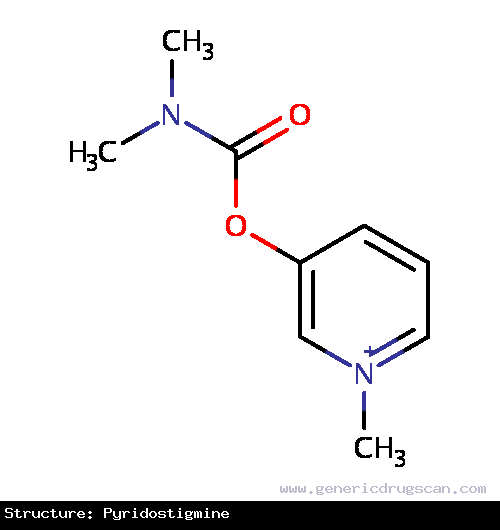Pyridostigmine Drug: Indication, Dosage, Precaution, Side Effect , Storage, Category Type and corresponding Brands - www.genericdrugscan.com
Pyridostigmine
Drug Status in USA : ApprovedDrug Status in Canada : Approved
pronunciation
pronounced as (peer id oh stig' meen)
Why is this medication prescribed?
Pyridostigmine is used to decrease muscle weakness resulting from myasthenia gravis.
This medication is sometimes prescribed for other uses; ask your doctor or pharmacist for more information.
How should this medicine be used?
Pyridostigmine comes as a regular tablet, an extended-release (long-acting) tablet, and a syrup to take by mouth. It usually is taken once, twice, or several times a day, depending on the type of tablet. Your doctor may change your dose, depending on how you respond to the drug. When you first start taking pyridostigmine, your doctor may want you to keep a daily record of the time you take each dose, how long you feel better after taking each dose, and if you have side effects. This record will help the doctor decide how much drug is best for you.
Follow the directions on your prescription label carefully, and ask your doctor or pharmacist to explain any part you do not understand. Take pyridostigmine exactly as directed. Do not take more or less of it or take it more often than prescribed by your doctor.
Continue to take pyridostigmine even if you feel well. Do not stop taking pyridostigmine without talking to your doctor.
Pyridostigmine overdose can cause severe illness, including muscle weakness. It is very hard to tell the difference between too little and too much pyridostigmine. Call your doctor immediately if your symptoms become worse.
What are the precautions to be followed?
Before taking pyridostigmine,- tell your doctor and pharmacist if you are allergic to pyridostigmine, bromides, or any other drugs.
- tell your doctor and pharmacist what prescription and nonprescription medications you are taking, especially allergy or cold medications, dexamethasone (Decadron), hydrocortisone (Hydrocortone), magnesium-containing products, medications for heart arrhythmias, sleeping pills, and vitamins.
- tell your doctor if you have or have ever had intestinal or bladder blockage, asthma, seizures, heart or kidney disease, thyroid problems, or stomach ulcers.
- tell your doctor if you are pregnant, plan to become pregnant, or are breast-feeding. If you become pregnant while taking pyridostigmine, call your doctor.
- you should know that this drug may make you drowsy. Do not drive a car or operate machinery until you know how this drug affects you.
- remember that alcohol can add to the drowsiness caused by this drug.
What are possible side effects of this medication ?
Pyridostigmine may cause side effects. Tell your doctor if any of these symptoms are severe or do not go away:- upset stomach
- diarrhea
- vomiting
- drooling
- pale skin
- cold sweats
- blurred vision
- watery eyes
- increased urge to urinate
- anxiousness and feelings of panic
- muscle weakness
- severe itching, skin rash, or hives
- slurred speech
- confusion
- seizures
- difficulty breathing
How to store the medication and dispose it of after its use later?
Keep this medication in the container it came in, tightly closed, and out of reach of children. Store it at room temperature and away from excess heat and moisture (not in the bathroom). Throw away any medication that is outdated or no longer needed. Talk to your pharmacist about the proper disposal of your medication.
Drug Category/Class
- Cholinesterase Inhibitors
- Parasympathomimetics
- Antimyasthenic Agents
- Nervous System
- Anticholinesterases
- CYP3A4 Inhibitors
- Anticholinesterases
| Prescribed | For the treatment of myasthenia gravis. |
| Weight : | 181.2117 |
| Structure | Pyridostigmine |
 | |
| Formula | C9H13N2O2 |
Pyridostigmine has 9 Brands listed
| Distinon (60 mg) | Gravitor (60 mg) |
| Gravitor SR (180 mg) | Mestinon (60 mg) |
| Mustone (60 mg) | Myestin (30 mg) |
| Myestin (60 mg) | Pyrido (60 mg) |
| Trostigmin FC (60 mg) |
Search Generic Drugs alphabetically
